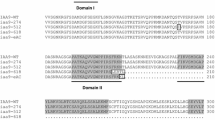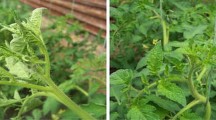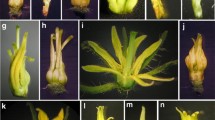Abstract
Genetic chimeras of the VFNT cherry tomato line (Lycopersicon esculentum) were produced by mutagenizing seeds with ethyl methane sulfonate (EMS). The chimeras thereby produced were evaluated by progeny-testing the fruits of the genetically mosaic tissue. A total of 2011 M1 plants was grown from treated seeds and evaluated by screening their 95175 (M2) progeny for mutations affecting seedling phenotype. Three vigorous and fertile M1 plants bearing mutant progeny with definitive phenotypes were selected for systematic harvesting and analysis. The specific location of each fruit was noted at harvest time, enabling the mutated sporogenous tissue of the mosaic M1 plants to be traced. Sectoring appeared in both branch and floral tissues. In several cases, mutant progenies were restricted to individual branches or parts thereof. True-breeding recessive mutants whose monogenic mode of inheritance was later established occasionally segregated within M1 fruit progenies at frequencies that indicate a non-homogeneous floral meristem origin. The data emphasize the necessity of making a well-distributed harvest of mosaic plants in order to detect as many variants as possible, as mosaic sectors may or may not recur late in ontogeny and may not contribute to sporogenous tissue early in development.
Similar content being viewed by others
References
Brown B (1984) Hematology: principles and procedures, 4th edn. Lea and Febiger, Philadelphia
Christou P (1990) Morphological description of transgenic soybean chimeras created by the delivery, integration and expression of foreign DNA using electric discharge particle acceleration. Ann Bot 66:379–386
Gurdon JB (1974) The control of gene expression in animal development. Harvard University Press, Cambridge, Mass
Hayward H (1938) The structure of economic plants. Macmillan, New York
Hernandez-Bravo G (1967) Two new dwarf mutants and their relations. Tomato Gen Coop Rep 17:30–31
Hildering G, Verkerk K (1965) Chimeric structure of the tomato plant after seed treatment with EMS and X-rays. In: The use of induced mutations in plant breeding. Pergamon Press, New York, pp 317–320 (Rep FAO and IAEA)
Krieg D (1963) Specificity of chemical mutagenesis. Prog Nucleic Acid Res 2:125–168
Miller P, Vaughn K, Wilson K (1984) Ethyl methanesulfonate-induced chloroplast mutagenesis in crops. J Hered 75:86–92
Mutschler M, Tanksley S, Rick C (1987) Linkage maps of the tomato (Lycopersicon esculentum). Tomato Gen Coop Rep 37:5–34
Rick C, Butler L (1956) Cytogenetics of the tomato. Adv Genetics 8:267–382
Rick C, Sawant A (1952) The j-lf situation. Tomato Gen Coop Rep 2:10
Satina S, Blakeslee A, Avery A (1940) Demonstration of the three germ layers in the shoot apex of Datura by means of induced polyploidy in periclinal chimeras. Am J Bot 27:895–905
Steward FC, Mapes MO, Kent AE, Holsten RD (1964) Growth and development of cultured plant cells. Science 143:20–27
Vasil V, Hildebrandt AC (1965) Differentiation of tobacco plants from single isolated cells in microcultures. Science 150:889–892
Author information
Authors and Affiliations
Rights and permissions
About this article
Cite this article
Farrell, M. Chimeras for mutations induced in dormant tomato seeds. Sexual Plant Reprod 7, 194–200 (1994). https://doi.org/10.1007/BF00228493
Received:
Accepted:
Issue Date:
DOI: https://doi.org/10.1007/BF00228493




